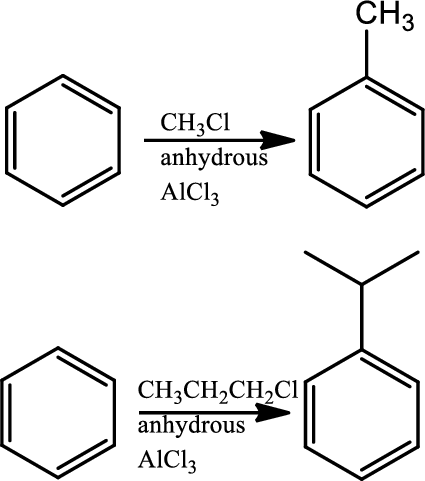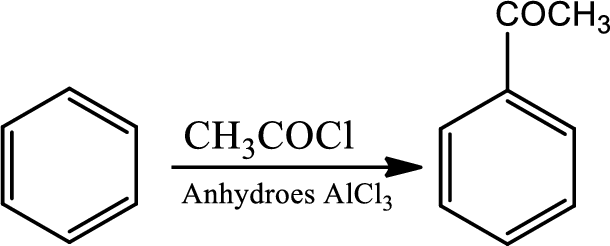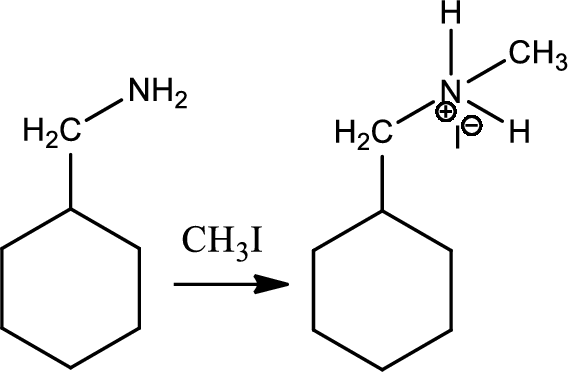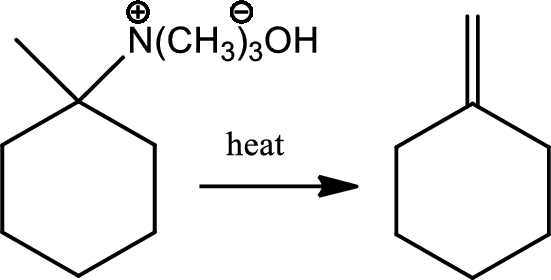
Concept explainers
We now continue the use of
To make your own roadmap for Chapters 20–23, take a blank sheet of paper and write the following

We now continue the use of organic chemistry reaction roadmaps. Because of the unique nature of the new reactions presented, we recommend that you make a new roadmap only for Chapters 20–23.
To make your own roadmap for Chapters 20–23, take a blank sheet of paper and write the following functional groups in the orientations shown. Fill the entire sheet of paper and leave plenty of room between functional groups. Most students find it helpful to use a poster-sized sheet of paper filled out in landscape orientation.
Interpretation:
A reaction roadmap has to be made for the reactions in the study Guide sections of chapters 20-23.
Concept Introduction:
Aromatic substitutions:
Aromatic substitution can be of two types, those are electrophilic and nucleophilic. Aromatic electrophilic substitution is an organic reaction in which an atom that is attached to an aromatic system is replaced by an electrophile. For example nitration, sulphonation, acylation, alkylation, halogenation to aromatic ring is aromatic electrophilic substitution reaction.
Aromatic nucleophilic substitution reactions are those reactions where nucleophile replaces a good leaving group.
Sigmatropic reaction:
A sigmatropic reaction is a pericyclic reaction where the net result is change of one sigma bond to another sigma bond in an uncatalysed intramolecular process.
Explanation of Solution
The reaction road maps for the reactions in the study Guide section of chapters (20-23) will help us to find out the reactions in easy way. The section number indicates the respective reaction segments involved in the study guide section.
Chapters 20 roadmap reaction legend,
Reaction 20.1:
Electrophilic addition to conjugate diene:
Conjugated diene undergoes both 1,2-addition and 1,4-addition reactions with electrophiles often giving mixtures of both kinds of products. The ratio of 1,2-addition to 1,4-addition is temperature dependent. 1,2-addition products are kinetically controlled product and 1,4 addition products are thermodynamically controlled product. When a conjugated diene reacts with

Reaction 20.2:
Diels-Alder reaction:
Conjugated dienes react with certain type of molecules having double or triple bonds, known as dienophile, to form two new sigma bond and a ring structure on the lose of pi bond in a reaction called Diels-Alder reaction. This reaction takes place in a concerted mechanism without intermediates and involves a redistribution of six pi electrons in a cyclic transition state where the pi bond breaking and new sigma bond making occurs simulteneously. The configuration of the diene and dienophile is preserved. Formation of the endo adduct is favoured. This reaction is facilitated by having electron withdrawing groups on dienophile and electron donating groups on diene. The diene must be on s-cis conformation to react. Diels-Alder reaction is an example of

Reaction 20.3:
Claisen rearrangement:
The Claisen rearrangement is a powerful carbon-carbon bond forming chemical reaction. This rearrangement transforms an allyl phenyl ether to an ortho-substituted phenol. This rearrangement is an exothermic, concerted pericyclic reaction. The kinetics are first order and the whole transformation proceeds through a highly ordered cyclic transition state and it is intramolecular.

Reaction 20.4:
Cope rearrangement:
Cope rearrangement is the

Chapters 21 roadmap reaction legend,
Reaction 21.1:
Acid base reaction of phenol:
Water soluble phenols react with the strong bases to give water soluble salts.

Reaction 21.2:
Kolbe synthesis:
Kolbe synthesis is a carboxylation chemical reaction that involves heating of sodim phenoxide with carbon dioxide and then treating the final product with sulfuric acid. This is basically nucleophilic addition of phenoxide to carbon dioxide that gives substituted cyclohexadienone which undergoes keto-enol tautomerism to regenerate aromatic ring. This gives maily ortho product which is known as salicylic acid.

Reaction 21.3:
Oxidation of phenols to quinone:
Phenols can be easily oxidised to quinone. Oxidation of phenols by

Reaction 21.4:
Oxidation at benzylic position:
The benzylic carbon bonded hydrogen is weak and oxidation at benzylic position is to break the benzylic

Reaction 21.5:
Halogenation at benzylic position:
Halogenation is regioselective for benzylic position and occurs by a radical chain mechanism. Bromination shows higher regioselectivity for a benzylic position than does chlorination. The reaction occurs via a radical chain mechanism which is initiated when the halohen molecule undergoes homolytic cleavage and gives two halide radical. One of the radical abstracts the benzylic hydrogen to create a resonance stabilised benzylic radical that reacts with another molecule of halogen to give the halogenated product and the new radical continues the chain reaction. NBS is used as the source of bromine.

Reaction 21.6:
Hydrogenolysis of benzylic ethers:
Bezylic ethers can be cleaved to give an alcohol or toluene using catalytic hydrogenation of (

Chapters 22 roadmap reaction legend,
Reaction 22.1:
Halogenation:
In halogenation reaction, aromatic ring reacts with chlorine in the presence of lewis acid catalyst

Reaction 22.2:
Nitration:
This is a type of electrophilic substitution on aromatic ring. The electrophile is the nitronium ion

Reaction 22.3:
Sulfonation:
This is a type of electrophilic substitution on aromatic ring. The electrophile is either

Reaction 22.4:
Fridel-craft’s alkylation:
This is a type of electrophilic substitution on aromatic ring. The electrophile is a carbocation formed as an ion pair interaction of haloalkane with lewis acid. Rearrangements from a less stable carbocation to more stable carbocation are common, the mechanism involves an initial reaction between the haloalkane and lewis acid

Reaction 22.5:
Fridel-craft’s acylation:
This is a type of electrophilic substitution on aromatic ring. The electrophile is an acylium cation formed as an ion pair by interaction of an acyl halide with a lewis acid. The mechanism involves an initial reaction between the acid chloride and lewis acid

Reaction 22.6:
Alkylation using alkene:
This is a type of electrophilic substitution on aromatic ring. The electrophile is a carbocation fromed by the reaction between the alkene and acids.

Reaction 22.7:
Alkylation using alcohols:
This is a type of electrophilic substitution on aromatic ring. The electrophile is a carbocation formed from an alcohol reacting with acid.

Chapters 23 roadmap reaction legend,
Reaction 23.1:
Alkylation of ammonia and amine:
Alkylation of amine is a type of organic reaction between an alkyl halide and ammonia or amine. This is nucleophilic aliphatic substitution and the reaction product is higher substitued amine. But the problem with the reaction is the overalkylation.

Reaction 23.2:
Alkylation of azide ion followed by reduction:
Azides are prepared by the treatment of a primary or secondary haloakane or an epoxide with

Reaction 23.3:
Nitrosation of tertiary aromatic amines:
This is an electrophilic aromatic substitution. The electrophile here is the nitrosyl cation which is very weak and participates in electrophilic aromatic substitution only with highly activated aromatic rings.

Reaction 23.4:
Formation of N-nitrosamine from secondary amines:
This is an electrophilic aromatic substitution. The electrophile here is the nitrosyl cation which reacts with secondary amine to give N-nitrsoamine.

Reaction 23.5:
Diazotisation reaction:
Diazonium salta are organic compounds having

Reaction 23.6:
Conversion of primary aryl amine to phenol:
Formation of an arenediazonium salt followed by loss of nitrogen gives an aryl cation intermediate which then reacts with water to give a phenol.

Reaction 23.7:
Schiemann reaction:
The Schiemann reaction is a chemical reaction in which a primary amine is transformed to an aryl fluoride via diazonium tetrafluoroborate intermediate.

Reaction 23.8:
Sandmeyer reaction:
The Sandmeyer reaction is a chemical reaction used to synthesize aryl halides from aryl diazonium salts using copper salts as reagents or catalysts. It is an example of a radical nucleophilic aromatic substitution. The Sandmeyer reaction provides a method through which the unique transformation on benzene such as halogenation, cyanation, trifluoromethylation and hydroxylations can be done.

Reaction 23.9:
Reaction of arenediazonium salt with KI:
Reaction of arenediazonium salt with KI is the most convinient way of introducing iodide to benzene ring.

Reaction 23.10:
Reduction of arenediazonium salt with hypophosphorus acid:
By this pathway amine or nitro group can be removed from benzene ring.

Reaction 23.11:
Hoffmann elimination:
Reaction of a quarternary ammonium halide with moist silver oxide to produce a quarternary ammonium hydroxide followed by heating to give an alkene is a reaction known as Hoffmann elimination. The mechanism involves the simultenous deprotonation of a beta hydrogen by base and los of the amino group in an anti geometry. In this process less substituted alkene is formed.

Reaction 23.12:
Cope elimination:
Treatment of the tertiary amine with hydrogen peroxide gives an amine oxide which on heating gives an alkene and an N,N-dialkylhydroxyamine in the reaction is known as Cope elimination. The elimination is syn stereoselective and involves a cyclic flow of six electrons in planar transition state.

Reaction 23.12:
Reaction of cyclic beta amino alcohol with nitrous acid:
Treating a cyclic beta amino alcohol with nitrous acid leads to rearrangement and a ring expanded ketone. The mechanism involves an initial formation of diazonium ion followed by simulteneous loss of nitrogen and rearrangement by a 1,2-shift to give a resonance stabilised cation that loses a proton to give the product cyclic ketone.

Thus, the reaction roadmap for the reactions in the study Guide section of chapters can be made as shown below for the chapters question 20-23,

Figure-1
Want to see more full solutions like this?
Chapter 20 Solutions
OWLv2 with MindTap Reader, 1 term (6 months) Printed Access Card for Brown/Iverson/Anslyn/Foote's Organic Chemistry, 8th Edition
- What is the name of the major product formed during the reaction between benzoyl chloride and phenol? benzyl ester O phenyl benzoate ○ cyclopentanoate ○ benzyl phenoate ○ benzenecarboxylic acidarrow_forwardProvide the proper IUPAC or common name for the following compound. Dashes, commas, and spaces must be used correctly.arrow_forwardProvide the proper IUPAC name (only) for the following compound. Dashes, commas, and spaces must be used correctly. HO. OHarrow_forward
- Question 2 0/1 pts Provide the proper IUPAC name only for the following compound. Dashes, commas, and spaces must be used correctly. HO CH 3 1-methyl-1-cyclohexanecarboxylic acidarrow_forwardPlease assign all the carbons for C-NMR and hydrogen for H-NMR. Please if I can get that less than hourarrow_forwardAssign these peaks spectrum ( H-NMR and C-NMR)arrow_forward
- 3. For the following reaction, what are the major product(s) mechanism for this reaction ? and draw the full Br Brarrow_forward4. Show the product(s) for the following reaction if it proceeds via the S42 mechanism AND if it proceeds via an Syt mechanism? Draw the mechanisms for both reactions and show all resonance structures for any intermediates. Would you expect the Su or Sy2 reaction to be favoured and why? NGOarrow_forwardI have a question here so in essence were just comparing the electronegativity values that are being given, soC and Cl, C and O, C and H to determine the partially positive, partially negative charges? So option I: Cl and C, option 2 O and C, option III C on its own correct?arrow_forward
 Organic ChemistryChemistryISBN:9781305580350Author:William H. Brown, Brent L. Iverson, Eric Anslyn, Christopher S. FootePublisher:Cengage Learning
Organic ChemistryChemistryISBN:9781305580350Author:William H. Brown, Brent L. Iverson, Eric Anslyn, Christopher S. FootePublisher:Cengage Learning
